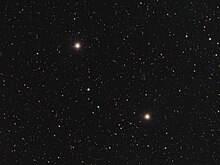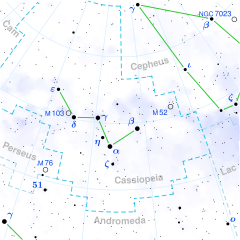| Observation data Epoch J2000.0 Equinox J2000.0 (ICRS) | |
|---|---|
| Constellation | Cassiopeia |
| Right ascension | 00h 55m 00.15523s[1] |
| Declination | +58° 58′ 21.7108″[1] |
| Apparent magnitude (V) | 4.82[2] |
| Characteristics | |
| Spectral type | K2 III[3] |
| U−B color index | +1.25[2] |
| B−V color index | +1.21[2] |
| Astrometry | |
| Radial velocity (Rv) | −23.57[4] km/s |
| Proper motion (μ) | RA: −33.50±0.36[1] mas/yr Dec.: −40.82±0.33[1] mas/yr |
| Parallax (π) | 9.93 ± 0.49 mas[1] |
| Distance | 330 ± 20 ly (101 ± 5 pc) |
| Absolute magnitude (MV) | −0.644[4] |
| Details | |
| Mass | 1.39[5] M☉ |
| Radius | 21[6] R☉ |
| Luminosity | 174[5] L☉ |
| Surface gravity (log g) | 1.76[4] cgs |
| Temperature | 4,422±14[5] K |
| Metallicity [Fe/H] | −0.25[4] dex |
| Rotational velocity (v sin i) | 1.1[7] km/s |
| Age | 4.75[5] Gyr |
| Other designations | |
| Database references | |
| SIMBAD | data |

Upsilon1 Cassiopeiae (υ1 Cassiopeiae) is an astrometric binary[9] star system in the northern constellation of Cassiopeia. It is visible to the naked eye with an apparent visual magnitude of 4.82.[2] Based upon an annual parallax shift of 9.93 mas as seen from Earth,[1] this system is located about 330 light years from the Sun.
The visible component is an evolved K-type giant star with a stellar classification of K2 III.[3] With an estimated age of 4.75 billion years,[5] it is a red clump star that is generating energy through the fusion of helium at its core.[10] The measured angular diameter, after correction for limb darkening, is 1.97±0.02 mas.[11] At the estimated distance of the star, this yields a physical size of about 21 times the radius of the Sun.[6] It has 1.39 times the mass of the Sun and is radiating 174 times the Sun's luminosity from its expanded photosphere at an effective temperature of 4,422 K.[5]
There is a magnitude 12.50 visual companion at an angular separation of 17.80 arc seconds along a position angle of 61°, as of 2003. A more distant magnitude 12.89 companion lies at a separation of 93.30 arc seconds along a position angle of 125°, as measured in 2003. Neither star appears to be physically associated with υ1 Cas.[12]
- ^ a b c d e f Cite error: The named reference
vanLeeuwen2007was invoked but never defined (see the help page). - ^ a b c d Cite error: The named reference
Argue1966was invoked but never defined (see the help page). - ^ a b Cite error: The named reference
rob51was invoked but never defined (see the help page). - ^ a b c d Cite error: The named reference
Soubiran2008was invoked but never defined (see the help page). - ^ a b c d e f Cite error: The named reference
Luck2015was invoked but never defined (see the help page). - ^ a b Cite error: The named reference
lang2006was invoked but never defined (see the help page). - ^ Cite error: The named reference
DeMedeiros2000was invoked but never defined (see the help page). - ^ Cite error: The named reference
SIMBADwas invoked but never defined (see the help page). - ^ Cite error: The named reference
Eggleton2008was invoked but never defined (see the help page). - ^ Cite error: The named reference
Valentini2010was invoked but never defined (see the help page). - ^ Cite error: The named reference
Richichi2005was invoked but never defined (see the help page). - ^ Cite error: The named reference
Mason2014was invoked but never defined (see the help page).
